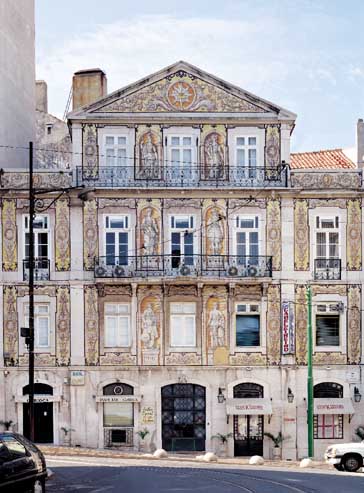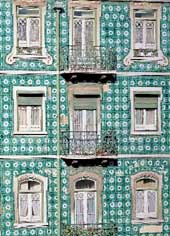|
|
|
|
|
|
|
|
|
|
|
|
|
 |
|
|
|
|
|
|
|
|
|
|
 |
The XIX Century
Azulejo façades
|
 ith the definitive rise of a bourgeoisie linked to trade and industry, (re)born out of the economic chaos into which Portugal was plunged after the French invasions (1807-1811) and the civil war between the Absolutists and the Liberals (1832-1834), a new use had been found for the Portuguese tile. ith the definitive rise of a bourgeoisie linked to trade and industry, (re)born out of the economic chaos into which Portugal was plunged after the French invasions (1807-1811) and the civil war between the Absolutists and the Liberals (1832-1834), a new use had been found for the Portuguese tile.
In the second half of the XIX century the less expensive standard-pattern tile covered thousands of façades. It was produced by factories in Lisbon (Viúva Lamego, Sacavém, Constância and Roseira) and Oporto and Gaia (Massarelos and Devezas).
Using either semi-industrial or industrial techniques that made production more rapid and precise, their colour and variations of light turned façades composed of standard-pattern tiles with borders delimiting doors and windows into essential elements of the Portuguese urban identity.
Two styles of tile developed in the main factories, which were concentrated in Lisbon and Oporto. In the north of the country, tiling was characterised by its use of pronounced relief and a taste for volume and contrasts between light and shade; the south maintained the smooth, flat patterns of ancient times, but transposed them from the interior of buildings to an almost ostentatious external application on their façades.
|
|
|
|
|
|
 |
|
|
|
Azulejo Façade,
Largo Rafael Bordalo Pinheiro,
Lisbon, Ferreira das Tabuletas, 1864.
photograph: Nicolas Lemonnier
|
|
|
|
|
|
|
|
|
|
|
 |
|
|
|
 |
|
|
|
|
|
|
|
|
|
|
Azulejo Façade, Rua dos Anjos,
Lisbon, beginning of the XX century.
photograph: Carlos Monteiro (DDF-IPM)
|
|
|
|
|
|
|
|
Azulejo Façade, Rua Marquês de Abrantes,
Lisbon, 2nd half of the XIX century.
photograph: Nicolas Lemonnier
|
|
|
|
|
|
|
© Instituto Camões, 2000
|
|
|
|
|